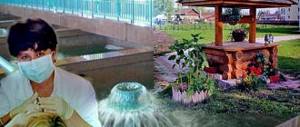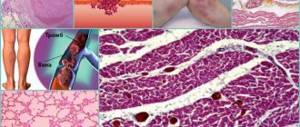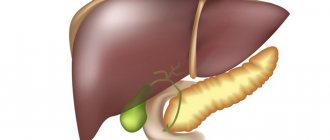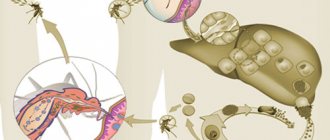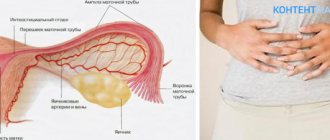Uraturia is a condition of the body during which urate crystals precipitate in the urine. They appear from uric acid due to an increase in the concentration of its salts. By accumulating and merging, these crystals can form stones of quite large diameter. A disease called nephrolithiasis occurs, that is, the presence of kidney stones.
This pathology brings many inconveniences to patients. It is dangerous not only with periodic outbreaks of renal colic due to the advancement of stones, but also with the risk of expansion or rupture of the cup-and-bowl system of the kidneys or ureters.
Urate nephrolithiasis occurs due to disruptions in the water-salt balance and disturbances in the body's metabolic processes. There are a huge variety of trigger factors that can cause stones to appear. They can be both internal and external. For example, a hereditary tendency is the presence of a similar disease in close relatives. Also, the abuse of sour or too spicy foods and the use of hard liquids as drinking water can contribute to the development of pathology.
Diet for urate in the urine is the main method of treatment, since drug therapy will be meaningless without dietary adjustments. After all, more and more new stones will be formed. Also, in some cases, doctors may resort to surgical methods of treating pathology.
Features of treatment
The basis of therapy for urolithiasis is diet. Medications are also used, but without dietary adjustments, taking them is simply pointless. Most often prescribed:
- Asparkam – promotes partial dissolution and removal of urates from the body.
- Allopurinol is a drug that has proven its effectiveness in the fight against uraturia. It breaks down already formed stones, and also has an effect on the enzyme that takes part in the uric acid processing cycle. As a result, the amount of urea is significantly reduced.
- Urolesan is a medicine created on the basis of herbs. It in no way affects the stones themselves, but improves the functioning of the urinary system and promotes better urine flow.
Blemarene also helps dissolve salts. The therapeutic effect is achieved due to the ability of the drug to make the urine environment more alkaline, which makes it easier for urates to decompose and be eliminated.
Nutrition correction
A properly selected diet for urate in the urine in most cases allows you to get rid of the unpleasant symptom and avoid complications.
The basic principles of diet therapy are based on the following points:
- strict adherence to daily caloric intake - the patient should not consume more than 2700-2800 kcal per day;
- carbohydrate products should be the basis of nutrition - up to 400 g per day;
- the amount of proteins in the diet – up to 80 g, lipids – up to 90 g;
- the menu should be designed for 5 meals;
- prohibition of consumption of cold dishes and products;
- 1-2 times a week there should be fasting days (on milk, fruits or vegetables).
Prohibited Products
There are a number of foods that those who want to never have to deal with uraturia will have to completely exclude from their diet. These include:
- purchased water, since it contains a large amount of calcium salts;
- alcohol, especially beer and red wines;
- cocoa products, chocolate;
- canned products;
- offal - liver, hearts, lungs, etc.
- broths based on fatty fish or meat;
- lard, sunflower oil;
- fatty meats and fish.
Some foods should be limited, but there is no need to completely abandon them:
- bread products;
- spices and herbs;
- dietary varieties of fish and meat, that is, low-fat;
- greens - spinach, sorrel.
- salt;
- plants that belong to the legume family.
Diagnosis of kidney stones
We recommend!
To treat kidneys, our readers use this very cheap remedy... Read more...
The first step towards establishing a diagnosis for a patient with suspected kidney stone disease is a survey. The doctor asks the patient about all the symptoms that he may have noticed, asks whether the patient has noticed blood in the urine, whether he has lower back pain, whether he has had kidney stones before, etc.
At the next stage of diagnosis, the doctor prescribes laboratory tests. These primarily include blood tests. For example, a clinical blood test can show the presence of an associated infection, and a biochemical blood test will certainly show the concentration of calcium, uric acid, inorganic phosphorus, and magnesium in the blood. Excessive amounts of these substances may indicate metabolic disorders in the body.
At the same stage, urine tests are certainly carried out. First, a general urine test to detect red blood cells, white blood cells, salt crystals, and bacteria. Secondly, urine samples of Nechiporenko, Addis-Kakovsky, Amburge, etc. Thirdly, urine culture for bacterial flora. And last, but not least in importance, is a biochemical urine test, which determines the salts and amino acids present in the urine.
At the third stage of diagnosis, the doctor uses instrumental studies. By that time, he already has a certain clinical picture, the doctor already has certain hypotheses and can determine what studies are needed to clarify the full picture and establish a final diagnosis.
Instrumental diagnostics include:
- ultrasound examination of the kidneys;
- plain and contrast radiography;
- computed tomography and magnetic resonance imaging;
- cystoscopy;
- radioisotope nephroscintigraphy.
The simplest, most accessible, but at the same time one of the most informative research methods is ultrasound. However, during this study, the doctor can assess the presence, position, size, etc. only a stone located directly in the kidney. If the stone is located in the ureters, then ultrasound examination will not detect it due to difficult access to the retroperitoneal space.
X-ray studies are very informative for diagnosing kidney stones. Typically, a plain radiograph is taken first. If this image does not show anything, but all other nephrolithiasis symptoms indicate the presence of stones, then the doctor prescribes a contrast radiography of the kidneys.
In this study, the patient is given intravenous contrast and then x-rays are taken. In the picture, the stones look like defects in the renal cavity. Contrast radiography provides complete information about whether there are kidney stones, their shape, size, quantity and location (if identified). However, this type of instrumental diagnostics cannot be called universal. The fact is that some kidney stones can be “invisible” or X-ray negative. These are, in particular, urates and cystine stones.
The most accurate, but at the same time quite expensive and difficult to access, methods for diagnosing kidney stones are computed tomography and magnetic resonance imaging. In the context of diagnosing kidney stones, these types of studies are important to establish the presence of X-ray negative stones, as well as the differential diagnosis of this disease with other diseases.
If a stone is suspected in the ureter, the doctor usually prescribes an inexpensive and accessible procedure such as cystoscopy. However, except for such a specific case, this research method has no special significance.
Carrying out radioisotope nephroscintigraphy involves intravenous administration of a radiopharmaceutical to the patient, which is excreted by the kidneys. Accordingly, during a subsequent scan of the organ, the doctor can evaluate its functionality.
Healthy foods
A list of foods that will not only be harmless, but will also bring certain benefits to the body:
- dairy products (cheese, sour cream, milk, cream);
- eggs;
- fruits;
- vegetables that make the urine environment more alkaline - pumpkin, watermelon, cucumber;
- eggplants, potatoes, carrots;
- foods that contain a lot of vitamin B - buckwheat, millet, pasta, sweet peppers;
- various berries;
- You also shouldn’t deny yourself the pleasure of eating any sweets.
Nutritionists allow citrus fruits to be included in an individual diet, however, this is permissible in the absence of oxalates in urine. If, however, a urine test confirms their presence, you should limit your consumption of oranges. Potatoes are also included in the list of restrictions.
Of great importance is the inclusion in the diet of dishes and products that have a diuretic effect:
- watermelon - you are allowed to eat up to 2 kg of product per day (provided there is no edema and fluid retention in the body);
- white cabbage – has a large amount of potassium in its composition, which removes excess fluid from tissues;
- compotes and juices based on cranberries are not only a diuretic, but also known for their bactericidal properties;
- strawberries (tea made from berries and leaves) – remove salts from the body;
- dill - used not only fresh, but also in the form of infusion;
- salad - its leaves are a powerful diuretic, from which you can make various snacks and sandwiches;
- melon - not inferior in quality to watermelon, seeds can also be eaten;
- pear – used fresh, in the form of purees, compotes, juices.
Etiopathogenesis of stone formation
It is important to know!
The kidneys will be cleansed instantly if you go on an empty stomach in the morning... A unique recipe from Elena Malysheva! Read more…
Even completely healthy kidneys always contain salts, but their concentration is moderate and they are excreted without problems in the urine. Due to pathogenic processes in the kidney, an imbalance occurs - the concentration of salt in the urine increases greatly, the reaction of the urine changes and the salts stop dissolving. Urinary tract infections aggravate this situation. As a result, the body cannot cope with removing salt from the body; a protein layer forms in the kidney, on which an excess amount of salt is deposited over time. This is how a kidney stone occurs, and this is the pathogenesis of nephrolithiasis.
Features of cooking
Despite the presence of urates in the kidneys, it is very difficult to refuse a deliciously cooked piece of meat. And this is not necessary, but the rules for its preparation should be treated scrupulously. The fact is that urate stones are formed from uric acid salts, in the formation of which the substances purines participate.
Purines are found in:
During cooking, a small part of the purines remains in the product itself, and the majority “goes” into the broth. This is exactly what sick people should not use. Here are some more tips on how to cook meat so that it is not only tasty, but also useful for patients:
- Before the heat treatment process, it should be kept in a saline solution for several hours. The same process must occur before preparing the kebab.
- Soups and borscht should be cooked in vegetable broth. The meat should be steamed separately, boiled, and added to the first dish at the time of serving.
- When cooking, meat should not be placed in cold water, but immediately in boiling water.
When it comes to fish products, you need to learn how to choose them correctly. Fish with a large layer of husk and developed gills will be useful.
Reasons for the development of nephrolithiasis
When the human body is healthy, the salts that are in the kidneys do not stay there but are released along with urine. Sometimes the natural process of cleansing the body of salts can be disrupted. When this happens, the urine becomes concentrated and condenses with particles of microorganisms. The result of this process is kidney stones that form after crystallization.
The main reasons for the development of nephrolithiasis:
- Poor nutrition;
- Increased sweating;
- Impaired ureteral patency;
- Infections;
- Rapid weight loss;
- Poor quality water;
- Sedentary lifestyle;
- Hereditary factor.
Menu for the day
A nutritionist will help you develop an individual menu. Over time, patients do this on their own.
Breakfast: semolina porridge with berries, tea, bread.
Snack: baked apple.
Lunch: vegetable soup, boiled meat, baked potatoes with vegetables, compote.
Dinner: cabbage zrazy, cottage cheese and pasta casserole, green tea.
The cause of urate in the urine is most often due to dietary errors - when a person eats a lot of meat and pays little attention to vegetables. Therefore, when you learn about uraturia, you should not panic. Most often, it is enough to consult a doctor who will select the right diet. But if you do not pay attention to this symptom, it can lead to the development of nephrolithiasis and even gout.
source: 2pochki.com
Leave a comment 12,561
Treatment of urolithiasis is carried out by a doctor, taking into account concomitant diseases, age and individual characteristics of the patient. A diet for urate kidney stones is prescribed to all patients with this pathology without exception. Often, strict adherence to it leads to the disappearance of symptoms, since urates are soluble, unlike other types of kidney stones. In severe cases, when correct adherence to diet recommendations alone is ineffective, drug therapy and surgical interventions are prescribed.
Signs and symptoms
For a long time, the course of kidney stone disease may be asymptomatic. About 15% of patients do not feel the presence of kidney stones. The size of the stones may vary. The intensity of symptoms depends on this. Smooth stones smaller than 3 mm can pass through the ureter on their own without causing discomfort. Larger stones may cause obstruction. There is an expansion of the overlying parts of the ureter, calyces and renal pelvis. This process is accompanied by a characteristic symptom - an acute attack of spasmodic pain in the lower back (renal colic). Sudden paroxysmal pain may appear after physical exertion or drinking large amounts of liquid.
Additional signs of nephrolithiasis:
- nausea;
- the presence of blood in the urine, its cloudiness;
- frequent urination;
- swelling of the limbs;
- headache;
- temperature;
- increase in pressure.
Long-term development of nephrolithiasis can lead to complications:
- renal failure;
- pyonephrosis;
- hydronephrosis;
- calculous pyelonephritis.
Note! Depending on the size and location of the stone, the nature of the pain can be expressed differently. It can be constant or periodic, dull or acute, and change its location as the location of the stone changes.
Diet No. 6 for urate stones
The formation of urate stones is a consequence of the deposition of calcium salts of uric acid. The purine bases from which it is formed in the body serve as the “building blocks” of DNA and proteins. Hereditary or acquired disorders of their metabolism lead to the manifestation of diseases such as urate kidney stones and gout. A diet for uraturia improves purine metabolism by eliminating foods rich in protein, alcohol and dietary components that disrupt the acid balance. The therapeutic effect of diet No. 6 for urates is as follows: take substances into food that shift the urine reaction to the alkaline side, and also increase the amount of fluid you drink.
Prohibited Products
- canned, pickled and salted vegetables;
- smoked meats, salty snacks;
- meat (pork, veal, duck, lamb);
- fish and seafood, caviar;
- strong meat and fish broths;
- fried, spicy, spicy;
- animal organs;
- refractory animal fats (pork - lard, lard, beef, goose);
- mushrooms and broths based on them;
- Rye bread;
- legumes (peas, lentils, beans);
- vegetables: radishes, celery, tomatoes, Brussels sprouts, asparagus, green beans;
- greens: sorrel, parsley, spinach;
- sour fruits and berries (pineapples, kiwi, cranberries, currants), dried fruits;
- chocolate, sweets, baked goods;
- any alcoholic drinks;
- sauces (soy, mustard, horseradish).
Return to contents
Products that form the basis of proper nutrition
- yesterday's white and gray bread;
- porridge and pasta;
- milk, sour cream (in small quantities), kefir, cottage cheese (up to 0.5 kg), butter (in moderation);
- eggs - 1 piece per day;
- vegetable, dairy, cereal soups, without frying;
- lean meat (preferably chicken, rabbit) no more than 1 time per day every 1-2 days, boiled;
- boiled fish no more than once a month;
- vegetables, except those prohibited, - raw, boiled, baked;
- nuts, seeds;
- non-acidic fruits and berries (bananas, plums, pears, blueberries).
Return to contents
Oxalate nephrolithiasis. Patient Management Options
21.11.2019
3404
0
| M.Yu. Prosyannikov Candidate of Medical Sciences, Head of the Department of Urolithiasis, Research Institute of Urology and Interventional Radiology named after. ON THE. Lopatkina - branch of the National Medical Research Center of the Ministry of Health of the Russian Federation (Moscow) |
In the program “An Hour with a Leading Urologist,” the studio guest was Candidate of Medical Sciences, Head of the Department of Urolithiasis at the Research Institute of Urology and Interventional Radiology named after. ON THE. Lopatkina Mikhail Yurievich Prosyannikov. He spoke in detail about the mechanisms of calcium oxalate urolithiasis and the available methods of conservative influence on this process.
The majority of all stones observed in patients with urolithiasis (KSD) are calcium oxalate. At the same time, as Mikhail Yuryevich noted, new drugs are now appearing that can help in the treatment of just such urolithiasis, but they can only be useful with a good understanding of how stones are formed and what mechanisms need to be affected to prevent stone formation.
According to an analysis of 12,992 studies conducted by the Research Institute of Urology conducted from 1990 to 2020, oxalate urolithiasis accounts for about 64% in men and 55.1% in women in the structure of urolithiasis. World statistics show approximately the same indicators: 50–70% of the total incidence of stones [1].
Mechanism of oxalate formation
As Mikhail Yuryevich recalled, depending on the chemical structure, two forms of calcium oxalate stones are distinguished: weddellites and wewellites (calcium oxalate dihydrate and monohydrate, respectively). From a clinical point of view, this is not of great importance, since both compounds cannot be dissolved by any means today. As soon as calcium combines with oxalic acid, a precipitate occurs. When combined with, say, citric acid, no precipitate is formed. This is the basis of one of the promising methods for the prevention of calcium oxalate urolithiasis: by increasing the proportion of citrates in the urine, the likelihood of calcium oxalate stones formation decreases.
Calcium oxalates may be present in the urine as crystals in patients without stones. They are visible on sediment microscopy.
For adequate kidney function, there must be a difference in urine pH in the pelvis and in the loop of Henle by approximately 2 units. The main risk factor for oxalate nephrolithiasis is a decrease in urine pH. At a certain stage, the calcium phosphate base prolapses into the cavity of the renal pelvicalyceal system. Thus, calcium oxalate stone grows on a calcium phosphate foundation.
Fig.1. Modern ideas about the pathogenesis of stone formation in urolithiasis, the formation of Randall’s plaque [6]
Up to 57% of people who do not have urolithiasis may still have Randall's plaques, whitish spots that indicate stone formation [2]. It is important to remember that KSD is a polyetiological disease, and for the formation of a stone, a confluence of several factors is necessary. Not in every case all the necessary factors are present immediately, but still the processes of stone formation are observed in many people
It is extremely difficult to influence Randall's plaques, primarily due to the lack of effectiveness criteria. At the same time, today it is possible to influence the concentration of those elements from which stones are formed.
“Swing” pH and stone formation
Salt crystals are poorly soluble in the urine of a person with a tendency to form stones, in particular due to the effect of pH on the excretion of the main stone-forming substances. The amount of excretion of calcium, uric acid, phosphate and magnesium is maximum at pH 5.6–5.8. In a healthy body, the balance of inhibitors and promoters does not allow stones to be deposited, despite excretion, but the most effective way to prevent stone formation is by adjusting the pH level.
A shift in urine pH to the acidic side (below 5.9–6) leads to an increase in the proportion of wavellite and oxalate component in urinary stones. To the alkaline side (from 5.1–5.3 to 6.1–6.9) - to the accumulation of a share of weddellite in stones. In general, a decrease in urine pH (less than 5.4) appears to play a more significant role in enhancing oxalate lithogenesis than calcium excretion.
Factors influencing calcium oxalate urolithiasis
Employees of the Research Institute of Urology, based on a sample of 708 people, analyzed what factors influence calcium oxalate urolithiasis. It was possible to identify 6 components:
- uricuria (increased level of uric acid excretion in urine) > 4.6 mM/day;
- magnesiumuria > 5.7 mM/day;
- calciuria > 6.2 mM/day;
- phosphaturia 30.9–36.9 mM/day;
- Urine pH is around 5.5;
- BMI 24.9–27.1 kg/m2.
To prevent calcium oxalate urolithiasis, it is necessary to influence, if possible, all these factors [3].
One of the confirmations of the influence of urine pH on the formation of calcium oxalate stones is also that the pH of morning urine in patients with uric acid urolithiasis is stable and is in the range of 5.0–6.0 (in the vast majority of cases - 5.0–5.5 ) [4]. When normalizing the pH level of urine, for example, using citrate mixtures, in 89.4% of cases, the disappearance of oxalate crystalluria is observed.
Effective and ineffective methods of prevention
Mikhail Yuryevich also emphasized the ineffectiveness of the approach in which, to treat ICD, patients are advised to reduce their dietary calcium intake - in this case, calcium begins to be washed out of the bones [5]. The normal level of calcium in the blood is 2.2–2.5 mmol/l.
Regarding the metabolism of oxalic acid, according to various clinical recommendations, the daily intake for patients with urolithiasis is from 50 to 150 mg of oxalates. Most of them are excreted in feces, about 20% remains. Another small part is synthesized in the liver. As a result, about 35 mg is excreted in urine[6]
Oxalates in the body are synthesized from amino acids - in particular glycine, glucose and ascorbic acid. Hyperoxaluria is divided into primary (types 1 and 2) and secondary (absorptive). Primary can be observed in the case of a mutation in the AGXT gene, leading to systemic damage to the body by oxalates. For this reason, liver transplants with normal AGXT enzymes are already being performed.
Additionally, the AGXT enzyme is activated by vitamin B6 intake. Therefore, it can be prescribed to patients with oxalate urolithiasis to reduce the concentration of oxalate in the urine. If primary hyperoxaluria is suspected, a genetic analysis is performed: the AGXT gene mutation is determined. Polymorphism of the ORAI1 (rs7135617), CASR (rs2202127), VDR and KL genes is also determined.
The risk of secondary hyperoxaluria increases with inflammatory diseases of the gastrointestinal tract, after resection of large sections of intestine, pancreatitis, and gallstones. Microorganisms also make a significant contribution: urease-producing bacteria (Proteus, Pseudomonas and Klebsiella) and oxalate-degrading bacteria (Oxalobacter formigenes, Lactobacter). To counteract them, correction of the intestinal microflora with eradication of urease-producing bacteria is required.
Patient Nutrition Assessment
For any type of stone, you should first evaluate the patient’s diet and understand what he eats ends up in the blood. Then the moment of transition of substances from the blood into the urine is monitored and the type of stone is determined. Diet assessment is carried out using the Eating Pattern Questionnaire (EPQ). Monitoring of urine pH, biochemical analysis of blood and urine for lithogenic disorders, and determination of the chemical composition of the stone are also carried out. There is evidence that 2 consecutive 24-hour urine collections 4–7 days apart can detect metabolic disorders in 80% of cases [7].
Dietary prerequisites for calcium oxalate urolithiasis are excessive intake of calcium, oxalates, purines and uric acid, plus insufficient intake of potassium, magnesium and vitamin B6. Thus, to prevent stone formation, it is necessary to normalize calcium intake to the level of 1000–1200 mg, reduce salt intake and restore the amount of vitamin B6. To normalize the level of oxalates in the urine, you need to limit the consumption of potatoes, spinach and chocolate, and also include more polyunsaturated fatty acids (salmon, tuna, mackerel, sardines, nuts, fish oil) in your diet. Adjusting urine pH levels can be achieved by alkalizing or acidifying the diet [8].
To normalize the level of citrates in urine, it is necessary to limit the volume of artificial carbonated drinks in the diet. In addition, natural, unpackaged juices of lemon/lime, orange and melon are rich in citrates.
According to the current recommendations of the European Association of Urology, when the urine calcium level is 5–8 mmol/day, citrate mixtures of 9–12 g/day and sodium bicarbonate 1.5 g per day are prescribed. When calcium levels are above 8 mmol/day, hypothiazide 25–50 mg/day, chlorthalidone 25 mg/day, indapamide 2.5 mg/day are prescribed.
In case of primary hyperoxaluria (excretion of oxalates > 1 mmol/day), genetic testing is first necessary to accurately identify the cause. Pyroxidine may be prescribed at a dose of 5 mg/kg per day (maximum up to 20 mg/kg per day). In case of secondary, intestinal (oxalate excretion 0.5–1 mmol/day), excessive consumption of oxalates is possible or gastrointestinal diseases are present: malabsorption syndrome, colitis, conditions after intestinal anastomoses and chronic diarrhea. The use of calcium and magnesium is prescribed, and the intestinal microbiota is also normalized.
For hyperuricuria (uric acid > 4 mmol/day), citrate mixtures 9–12 g/day or sodium bicarbonate 1.5 g 3 times/day are prescribed. In addition, allopurinol can be prescribed at 100 mg, 1 tablet/day and up to 300 mg/day in case of a significant increase in uric acid levels. It is important to monitor the predominance of vegetable protein in the patient’s diet.
Drugs for the correction of oxalaturia
To correct oxalaturia, the drug Oxalite can be used. It contains extracts of Fucus vesiculosus, Phyllanthus niruri and Desmodium styraxolifolia. At the Research Institute of Urology, a study of its effectiveness was conducted over 3 months with the participation of 30 patients. The biochemistry of the blood and 24-hour urine of patients was assessed for lithogenic disorders with the connection of remote monitoring.
Patients aged 18–66 years were divided into two equal groups of 15 people. The first received only dietary recommendations. The second one, besides them, was prescribed Oxalit for a period of 3 months.
At the first appointment of patients, the biochemistry of 24-hour urine was assessed: calcium, magnesium, oxalates, citrates, diuresis. At week 4, blood biochemistry was also assessed.
There were no significant changes observed in the diet group.
In the diet group with additional intake of Oxalit, a decrease in the average level of oxalates was noted from 0.23 to 0.11, as well as an increase in the amount of magnesium from 2.21 to 4.44.
In total, 30 patients performed more than 2,400 urine tests using a remote monitoring device - the portable ETTA AMP-01 analyzer. Analyzes performed using such a “home” urine analyzer are comparable to analyzes performed on stationary equipment, since both devices operate on the same test strips [9].
The relative density of urine was slightly increased in both groups. In addition, during observation, pH decreased slightly in both groups. As an important factor, Mikhail Yuryevich noted that the administration of Oxalit statically significantly reduced the number of red blood cells in the urine of patients.
Based on the results of the study, the authors came to the conclusion that when taking Oxalit, the level of oxalates in daily urine decreases by 2.1 times (p < 0.05), renal excretion of magnesium increases by 2 times (p < 0.05), and the degree of leukocyturia decreases and the level of protein in the urine (p < 0.05), as well as the level of erythrocyturia decreases 2.9 times to subnormal values (p < 0.05).
As Mikhail Yuryevich emphasized, until now there were no means in the arsenal of urologists that could influence the factors of calcium oxalate urolithiasis with such a degree of effectiveness.
Sources:
- Yee V. Wong et al., Int J Endo, 2015
- Stoller ML et al., J Urol, 1996
- Golovanov S. A. et al., Ex and wedge Urol, 2018
- Konstantinova O. V., Yanenko E. K., Urology, 2015
- Nagaraja Rao P. et al., Ur Tract Stone Disease, 2011
- Shestaev A. Yu., Ex and wedge Urol, 2013
- Bek-Jensen H. et al., Eur Urol, 1998 8. Manissorn J. et al., Sci Rep, 2020 9. Shaderkin I. A. et al., Ex and clin Urol, 2015
Material prepared by Yu.G. Boldyreva
The article was published in the journal Urology Digest No. 5-2019
Topics and tags
Urolithiasis disease
Comments
To post comments you must log in or register
Mineral water and other drinks with urates
According to their effects, waters are divided into three types: medicinal, medicinal-table and dining. The best results in dissolving stones can be achieved by using medicinal mineral water. For urates, it is more suitable to use alkaline waters, for example, “Borjomi”, “Essentuki No. 17”, “Naftusya”, “Polyana-Kvasova”. They should be drunk up to half a liter per day, warm, 30-40 minutes before meals. Medicinal table waters can be drunk up to 1-1.5 liters per day, and table waters - in unlimited quantities, if desired. Taking them has a pronounced diuretic effect, improves acid-base balance and dilutes salt deposits in the kidneys, preventing the formation of new stones.
Prescribing mineral water for urolithiasis should only be done under the supervision of a doctor.
In addition to the above-mentioned waters, when urates are deposited in drinks, you need to drink the following liquids: milk, fermented baked milk and kefir, compotes and uzvars, fruit drinks, weak tea, herbal infusions, rosehip decoction. In any pharmacy you can purchase kidney infusions based on medicinal plants such as horsetail, celandine, calamus, and stinging nettle. One of the principles of the urate diet is to avoid cocoa, coffee and strong tea, which not only increase the level of uric acid in the body, but also lead to dehydration, which results in the active formation of kidney stones. Patients whose urates are combined with other diseases, such as arterial hypertension and renal failure, should consult a doctor regarding their drinking regime. The general recommendation for them would be to reduce their intake of table salt and liquid.
Reasons for the formation of nephrolithiasis
The root cause of the formation of stones and sand in the kidneys is an excess of certain elements and salts in the body.
The root cause of the formation of stones and sand in the kidneys is an excess of such elements and salts in the body:
- Calcium oxalate;
- Calcium phosphates;
- Struvite and urate;
- Xanthine and cystine;
- Oxypurinol;
- Ammonium urate.
But at the same time, the provoking factors that lead to the precipitation of salts in the form of crystals are:
- Infectious and inflammatory processes in the urinary system;
- Stagnation of urine due to insufficient drinking;
- Deficiency of vitamins and minerals;
- Abnormal structure of the urinary tract;
- Changes in the length of the urinary ducts due to pregnancy, etc.;
- Inflammatory processes in the intestines;
- Genetic predisposition;
- The use of drastic diets for sudden weight loss;
- Uncontrolled use of certain groups of drugs.
Medical nutrition: delicious recipes
Borscht with vegetable broth
For one serving: 50 g tomatoes, 60 g beets, 130 g potatoes, 70 g carrots, 100 g cabbage, 10 g parsley, 30 g butter. Preparation: tomatoes (pre-peeled from seeds and skins), potatoes and carrots cut into cubes. Shred the cabbage. Boil all vegetables in a saucepan in boiling water. 15 minutes before the end of cooking, add grated beets, salt and season. Cook until done. Before serving, sprinkle with chopped parsley and add butter.
Potato and zucchini pancakes
For one serving: 1 pc. potatoes, 90 g zucchini, 1 tbsp. l. flour, ¼ chicken egg, vegetable oil for frying, 30 g sour cream, 15 g dill, 10 g garlic, salt and pepper to taste. Preparation: grate the zucchini and potatoes on a fine grater, squeeze. Add egg, flour, salt and pepper, mix thoroughly. Form pancakes in a heated frying pan greased with vegetable oil. Fry on both sides until golden brown. Serve with aromatic sour cream sauce: add finely chopped garlic and dill to the sour cream and stir.
Cottage cheese and pumpkin casserole
For one serving: 90 g cottage cheese, 100 g pumpkin, 2 tsp. semolina, 2 tbsp. l. sugar, ½ egg, 10 g butter, a pinch of soda, salt, lemon juice, 1 tbsp. l. sour cream. Preparation: Peel the pumpkin and grate it on a coarse grater. Mash the cottage cheese with butter. Add half a beaten egg, semolina, salt and sugar to the cottage cheese. Quench the baking soda with lemon juice and stir into the resulting mixture. Add pumpkin pulp to the dough. Place the casserole base in a greased baking dish and cook for 50 minutes at 200° C. Serve with sour cream.
Steamed minced veal cutlets with cheese
For one serving: 150 g minced veal, ½ medium onion, ½ chicken egg, 5 g butter, 30 g hard cheese, herbs, salt to taste. Preparation: mix minced veal with onion. Beat in the egg, salt and add seasonings to taste. Stir in butter. Grate hard cheese on a fine grater. Form some of the minced meat into a flat cake and put a pinch of cheese in the middle. Seal to form a cutlet. Do the same with the rest of the minced meat. Place the resulting cutlets in a steamer container and cook for 45 minutes. Serve, garnished with greens.
source: etopochki.ru
Doctors today diagnose urolithiasis in almost every second person. In their opinion, such sad statistics in most cases are explained by the deteriorating environmental situation, and in particular by the fact that we drink water of very low quality. Thus, one of the factors stimulating the occurrence of diseases of this kind are heavy metals present in drinking water, food and the air we breathe.
Urate kidney stones and causes of their appearance
The formation of urate stones in the kidneys is quite often a provoking factor in the development of various complications in other organs and systems of the human body. As a rule, uraturia occurs due to excessive accumulation of uric acid in the urinary organs, which, when decomposed, forms sand and small stones.
The production of uric acid is based on purine compounds, the source of which in the body are certain foods. It is worth noting that purines play an important role in the structure of DNA and proteins, but disruption of their metabolism often produces diseases such as urate kidney stones.
The main reasons for the formation of urate stones:
- violation of metabolic processes;
- low physical activity during the day;
- diseases of the digestive and genitourinary systems;
- abuse of spicy and sour foods;
- predisposition to this disease at the genetic level;
- disturbed water balance of the body. Excessive fluid loss can be caused by high fever, vomiting, and severe physical exertion;
- poor blood flow to the kidney.
The appearance of urate kidney stones can also be triggered by fasting or excessive consumption of foods that supply purine substances to the body, in particular:
- Protein-containing products: meat (especially fried), meat by-products and broths, legumes, mushrooms.
- Fish, including canned fish.
- Tomatoes.
- Alcoholic drinks.
- Chocolate.
It is important to know that the likelihood of urate kidney stones occurring is the same for both males and females. Moreover, this problem can be encountered at any age.
Nephrolithiasis. What is it and what are the causes?
Stone-like structures can appear in the kidneys, renal pelvis, and urinary tract. This process is characterized by the fact that substances that should normally be excreted are retained in the body and crystallize. It has been noticed that men have kidney nephrolithiasis much more often than women. The formation of stones is influenced by the nature of a person’s diet. The more fats, animal proteins, and foods high in acids he consumes, the higher the risk of nephrolithiasis. The disease can also be caused by a low level of urine excretion (increased sweating, small amount of fluid consumed). Frequent infections of the genitourinary system and metabolic disorders are other factors that contribute to the occurrence of the disease. A sedentary lifestyle and large weight losses can also affect the process of stone formation.
Diet for urate kidney stones
The main goal of the diet for this disease is to establish purine metabolism in the body by:
- eliminating the consumption of foods that disrupt the acid balance and contribute to the appearance of urates;
- alkalinization of urine, which will help remove kidney stones;
- normalization of water balance in the body. It is recommended to drink about 2-3 liters of liquid during the day.
Diet No. 6 from the official list of diets copes well with this task, helping to reduce the load on the urinary tract, normalize metabolic processes and prevent new formation of kidney stones.
Features of the diet in the fight against urates:
- The rate of calorie intake increases - up to 2800 Kcal per day.
- The basis of the diet is carbohydrates - about 400 grams per day. The amount of protein consumed is limited to 70-80 grams, fat - up to 90 grams per day.
- Do not eat food that is too cold.
- It is necessary to eat frequently - five meals a day.
- It is recommended to arrange fasting days for the body from time to time (for example, consume only one dairy food or only fruit during the day).
Symptoms
A person, completely unsuspecting, lives every day in a normal rhythm, while his kidneys are safely clogged with stones. Once they become too large or begin to move down the urinary tract, anything can happen to the patient. Initially, these are cutting and stabbing pains that focus on the lumbar line at the location of the organ. Further, the unpleasant sensation can spread lower and even reach the groin. The usual process of urination is disrupted, urine, its color and quantity changes, and an uncomfortable feeling appears during and after it.
List of prohibited foods for urate kidney stones
Patients are prohibited from:
- meat (veal, lamb, pork and duck) and meat broths;
- meat by-products;
- fish and broths cooked on its basis;
- smoked meats and canned food, including vegetable pickles;
- any mushrooms and broths prepared on their basis;
- legumes;
- vegetables and greens: lettuce, parsley, sorrel, spinach, celery stalks, tomatoes, radishes, asparagus and green beans, Brussels sprouts;
- fruits and berries with a high acid content, in particular: kiwi, pineapple, currants, cranberries;
- dried fruits;
- sweets: chocolate, candies of any kind;
- drinks: strong tea, coffee, cocoa, alcohol;
- baked goods made from yeast and puff pastry and bread made from rye flour;
- soy sauce, mustard, horseradish.
During the diet, you should avoid fried, spicy and spicy foods. It is also recommended to limit your salt intake.
Very often, patients are horrified by such a large list of restrictions, but do not worry, because there are also a huge number of permitted products.
According to the conditions of diet No. 6, when urate stones are deposited in the kidneys, dietary preference should be given to dairy and plant products that have an alkalizing effect.
Treatment methods for nephrolithiasis
Only after a complete diagnosis, taking into account all the examination data, a treatment method is prescribed.
There are different treatment methods:
- Conservative method. This method of treatment is also called medication. The doctor prescribes this method when small stones are found in the kidneys, which can pass on their own. In order for the treatment to be effective, a course of antibiotics is prescribed, which will help the body remove the stones, and also relieve inflammation and destroy the infection, if any. Pain relief medications are also prescribed. If it is possible to dissolve the stones chemically, the doctor will prescribe appropriate medications. Also, in the treatment of this disease, a diet is prescribed. The doctor sets the diet individually, taking into account all the features of human physiology.
- Laparoscopic method. This method involves surgery and removal of stones. The doctor removes large stones through a small incision. The surgical method is used for stones larger than 2.5 cm.
- Lithotripsy method. For this method, stones no larger than 2.5 cm in size are allowed. In this treatment of nephrolithiasis, stones are crushed using a special laser or ultrasonic waves. There are two types of this method, contact and non-contact. After applying this method, the stones are crushed inside the kidneys and then, using a conservative method, are removed from the human body. The combination of the Lithotripsy method together with the Conservative method is the most common in medicine today.
All these methods can also include diet as one of the methods for treating nephrolithiasis. Diet during treatment is very important as it prevents the appearance of stones in the human body, but depending on the stones themselves, the diet varies.
If you have urate stones, then you will have to limit yourself to fried and smoked meat. It will be necessary to give up legumes. Consumption of alcoholic food is prohibited. If the stones are calcium, then you will be limited in lactic acid products, coffee, carrots and other products that have identical indicators will be prohibited.
Allowed foods for urate kidney stones
List of permitted products:
- fermented milk products: milk, cottage cheese (up to 500g), kefir, sour cream and butter in moderate quantities;
- porridge and pasta;
- lean boiled meat (chicken and rabbit), but not more than once every two days;
- eggs – 1 pc. in a day;
- white and gray bread at least yesterday's prepared;
- milk and vegetable soups without frying, you can add any cereals;
- boiled fish once a month;
- any nuts or seeds;
- any vegetables (except prohibited ones). Potatoes can be consumed, but in limited quantities;
- fruits and berries with low acid levels. It is recommended to give preference to apples, pears, grapes, watermelons, as they best help in alkalizing urine;
- citrus fruits can be included in the diet if there are no oxalates in the urine, and if they are present, only oranges are allowed to be consumed, but in limited quantities;
- sweets: honey, jam, pastille, marmalade.
Drinking during the deposition of urate stones:
- Water:
- medicinal mineral water (“Borjomi”, “Essentuki No17”, “Polyana-Kvasova”, etc.). Alkaline mineral waters are excellent for dissolving stones. The norm per day is no more than half a liter. You should drink warm water half an hour before meals;
- medicinal table water – up to 1-1.5 liters per day;
- table water – can be consumed in unlimited quantities.
Important! In case of urolithiasis, mineral water is consumed only under the supervision and as prescribed by the attending physician.
- Fermented milk drinks: fermented baked milk, kefir, milk.
- Compotes from fresh or frozen fruits and berries.
- Fruit drinks.
- Teas: weak tea. Please note! Diet No. 6 involves a complete abstinence from drinks such as strong tea, cocoa and coffee, since their consumption is one of the main factors in the active formation of kidney stones. These drinks not only increase the level of uric acid in the body, but also contribute to dehydration.
- Herbal infusions and decoctions. Any pharmacy offers kidney preparations, which contain medicinal plants such as rose hips, stinging nettle, celandine and others.
The drinking regime of patients in whom the formation of urate stones occurs in combination with the development of other diseases (for example, arterial hypertension, renal failure, etc.) can only be established by the attending physician.
Prevention methods
To prevent the development of urolithiasis, it is necessary to follow a number of rules. It is very important to maintain a proper drinking regime. The amount of liquid a person drinks should be at least 1.5 liters. In addition, special attention must be paid to its quality. If you have hard water in your home, then you cannot do without high-quality filters. You should not overuse mineral waters, as they can provoke this disease. Proper nutrition can also protect against nephrolithiasis. If urates are detected, it is necessary to limit the amount of meat and offal. You should stop eating smoked meats. Oxalate stones have their own limitations. Foods that contain oxalic acid are prohibited. Sorrel, spinach, beans, citrus fruits, strawberries - this is an incomplete list of foods that can aggravate the situation. Phosphorus-carbonate formations require the exclusion of foods containing large amounts of calcium.
Some tips for preparing healthy meat dishes
As mentioned above, urate stones are formed when there is an excess amount of uric acid, the production of which is promoted by purine substances. Sources of large quantities of these substances are: meat products and offal, fish and mushrooms.
It is worth noting that it is the cooking of these products that allows you to get rid of most of the purines they contain, which, accordingly, remain in the broth . That is why it is strictly forbidden to consume meat, fish and mushroom broths if you have urate kidney stones, but you can treat yourself to a tasty boiled piece of meat.
Tip #1 . Before you start cooking the meat, it should be soaked in a saline solution for at least three hours.
Tip #2 . Soaked meat should be placed immediately in boiling water.
Tip #3 . When preparing first courses, meat should be cooked exclusively in a separate container and added to the plate already fully prepared.


